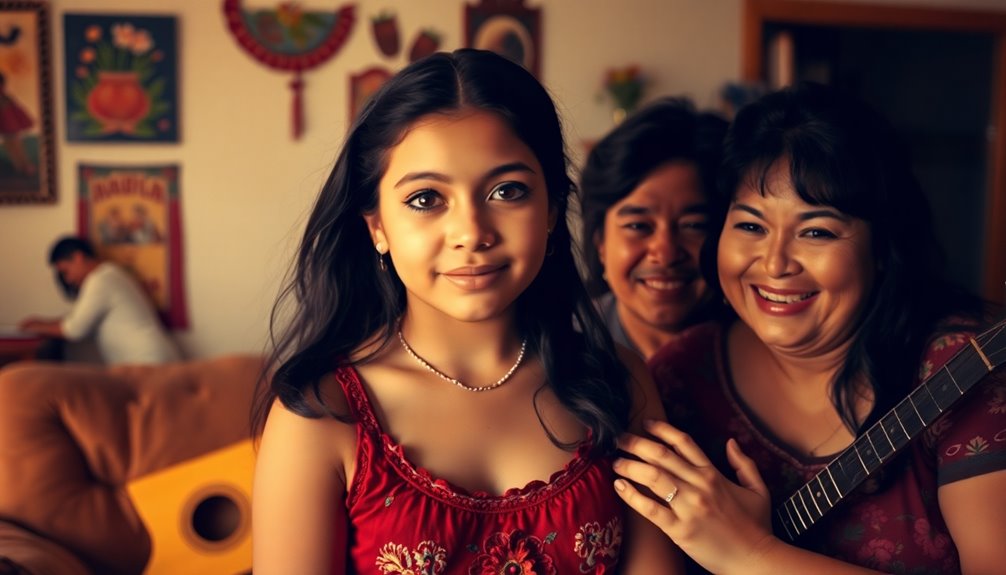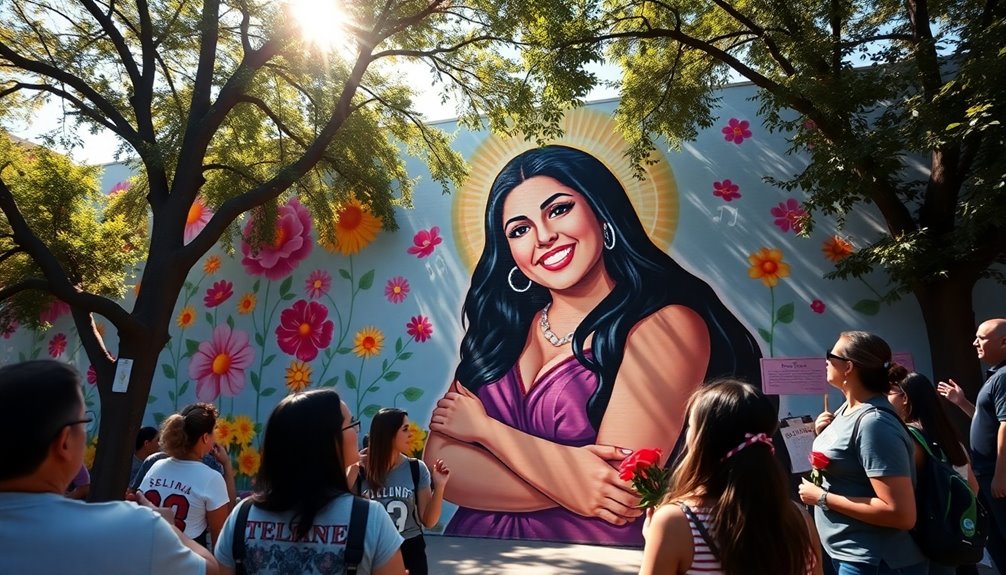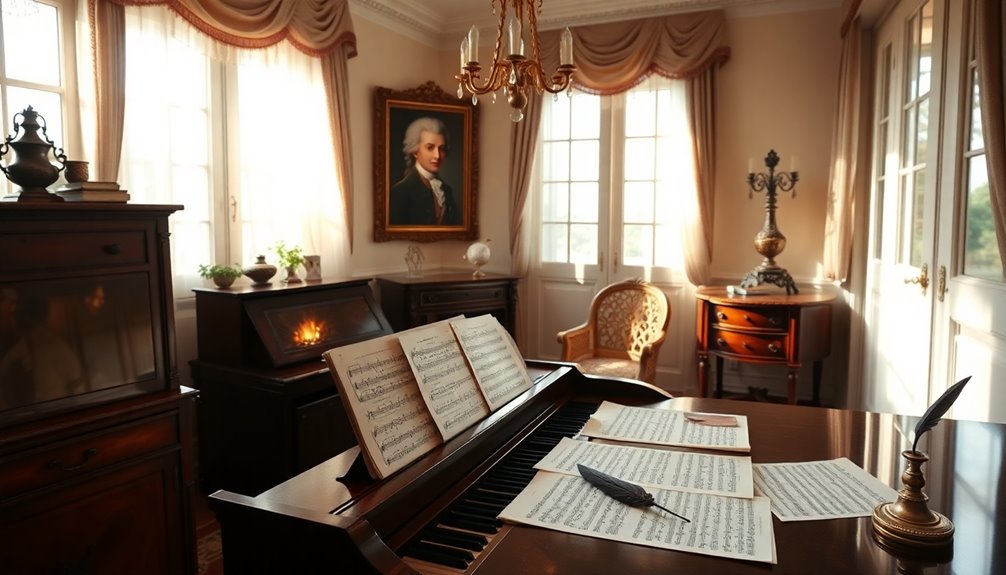Selena Quintanilla, known as the Queen of Tejano music, captivated audiences with her dynamic voice and unique style. Born on April 16, 1971, in Texas, she began singing at a young age, leading to the formation of her band, Selena y Los Dinos. With hits like "Amor Prohibido" and "Baila Esta Cumbia," Selena transformed the Tejano genre, blending various influences and reaching mainstream success. Tragically, her life was cut short in 1995, but her legacy endures through fierce fan devotion and numerous accolades. Keep going to uncover more about her journey and lasting impact on music and culture.
Key Takeaways
- Selena Quintanilla was a pioneering Tejano music artist, recognized for blending traditional and modern styles, revolutionizing the genre.
- She formed Selena y Los Dinos in 1981, achieving significant success with hits like "Baila Esta Cumbia" and "Amor Prohibido."
- Selena became the first female Tejano artist to win a Grammy Award in 1994 for her album *Live!*.
- Tragically murdered in 1995, her legacy endures through posthumous honors, including a star on the Hollywood Walk of Fame.
- Selena's influence transcends music, inspiring future generations and reshaping cultural perceptions of Latin music in mainstream markets.
Early Life and Family Background

Selena Quintanilla's early life was marked by a unique blend of cultural influences and family support that shaped her into a music icon. Born on April 16, 1971, in Freeport, Texas, she grew up in Lake Jackson before moving to Corpus Christi. At just six years old, her father, Abraham Quintanilla Jr., discovered her singing talent, and she began performing professionally at age nine.
Her family played a vital role in her development. With parents Abraham and Marcella, who married in 1963, Selena was raised in a household that valued music and culture. Her mother's Mexican-American and Cherokee heritage, combined with her father's musical background, provided a rich foundation. Despite financial struggles, including bankruptcy and eviction, her family remained supportive, allowing her to pursue her passion. Her family band played an essential role in the early stages of her career, helping her navigate the Tejano music scene.
Though she was raised as a Jehovah's Witness and taken out of school in eighth grade, Selena earned her high school diploma through correspondence. While learning Spanish phonetically for her music, she absorbed the Tejano genre's influences, ultimately setting the stage for her future success with her family band.
Formation of Selena Y Los Dinos

In 1981, the Quintanilla family took a major step toward realizing Selena's musical potential by forming the band Selena y Los Dinos. This group included Selena as the lead vocalist, her brother A.B. on bass guitar, and her sister Suzette on drums. Named "Selena and the Guys," they kicked off their performances at the family's restaurant, Papágayos, in Lake Jackson, Texas.
Initially, you'd hear a mix of English soft rock and Tejano music from them, but as they gained popularity, they shifted to focus exclusively on Tejano. The music drew influence from the vibrant Tejano scene in South Texas, incorporating elements of jazz, country, and German polka, often featuring the accordion, a staple in Tejano tunes.
A.B. emerged as a key songwriter and producer, while Suzette anchored the rhythm section. The band's lineup evolved with the addition of Pete Astudillo in 1987 and keyboardist Ricky Vela, both contributing to their sound. By 1988, Chris Perez joined as the lead guitarist, adding a rock flair that would enhance their music further. This solid foundation set the stage for their future success and ultimately led to their mainstream success after signing with EMI Latin.
Rise to Fame

As you explore Selena's rise to fame, you'll notice how her early career highlights set the stage for her success. Winning prestigious awards at the Tejano Music Awards and releasing hit albums in the late '80s launched her into the spotlight. This momentum only grew as she consistently broke records and connected with fans across the globe. Her unique stage presence and musical blend distinguished her from her peers, further solidifying her position in the music industry.
Early Career Highlights
From a young age, Selena Quintanilla's talent shone brightly, setting the stage for her remarkable rise in the music industry. You see, she began performing at just six years old with her family band, Selena y Los Dinos, at their restaurant, Papagayo. With her brother A.B. on bass and sister Suzette on drums, the family bonded over music while maneuvering financial struggles after their restaurant failed. Relocating to Corpus Christi, they performed at weddings, quinceañeras, and fairs, using their old bus, "Big Bertha," as their tour vehicle.
Despite facing challenges like being taken out of school in the eighth grade, Selena persevered. She learned Spanish phonetically to connect with her audience and opened for other Tejano bands during her early tours. Critics in the male-dominated genre doubted her, but she proved them wrong. By the time she turned 15, she won the Tejano Music Award for Female Vocalist of the Year in 1986, marking the beginning of her accolades. Signing with EMI Latin in 1989 solidified her place in music, and she began to build a loyal fan base through appearances on shows like the Johnny Canales Show. Her dedication to her craft culminated in her first major album, *Selena y Los Dinos*, which showcased her early Tejano music style and set the foundation for her future success.
Breakthrough Albums Success
Selena Quintanilla's rise to fame was propelled by several groundbreaking albums that showcased her incredible talent and enthralled audiences far beyond the Tejano music scene. Her 1990 album, *Ven Conmigo*, marked a significant turning point, featuring hits like "Baila Esta Cumbia" and expanding her reach into mainstream markets. Then came *Entre a Mi Mundo* in 1992, critically acclaimed as her true breakthrough. It topped the US Billboard Regional Mexican Albums chart for eight straight months and was certified 10× platinum, selling 600,000 album-equivalent units.
In 1993, Selena released *Live*, which won the Grammy Award for Best Mexican/American Album. This achievement made her the first female Tejano artist to receive a Grammy, solidifying her status as a mesmerizing live performer. Selena's music became integral to the Tejano genre, inspiring countless artists and helping to shape its future.
The following year, *Amor Prohibido* became one of the best-selling Latin albums in the United States, popularizing Tejano music among younger audiences. With chart-topping hits like "Amor Prohibido" and "No Me Queda Más," Selena's music resonated deeply, earning her numerous awards and establishing her as a pivotal figure in Latin music history.
Breakthrough Solo Career

With her signing to EMI Latin in 1989, Selena Quintanilla launched a breakthrough solo career that would redefine Tejano music. Her self-titled debut album, *Selena*, hit the U.S. *Billboard* Regional Mexican Albums chart at number seven, marking the start of her impressive journey. She quickly outpaced other female Tejano artists, fueled by music executive José Behar discovering her at the 1989 Tejano Music Awards.
In 1990, she released *Ven Conmigo*, becoming the first female Tejano musician to achieve gold status in the U.S. This was followed by *Entre a Mi Mundo* in 1992, which sold over 300,000 copies and became the best-selling Regional Mexican Album of 1993. The album *Live!*, released in 1993, won a Grammy Award and was certified gold, showcasing her dynamic performances. Additionally, she was recognized for her pioneering crossover appeal that helped pave the way for future Latin artists in mainstream music.
Her 1994 hit, *Amor Prohibido*, became a cultural phenomenon, achieving double Diamond status and solidifying her as a leading figure in Latin music. Following her tragic passing, *Dreaming of You* debuted at number one on the *Billboard* 200 chart, making history as the first mainly Spanish-language album to do so.
Musical Style and Influences

Tejano music, rooted in a blend of Spanish and American influences, became the canvas for Selena Quintanilla's innovative artistry. She revolutionized this male-dominated genre by infusing it with R&B and pop sounds, making her music accessible to a broader audience. You can see how her style combined traditional elements with modern flair in the following table:
| Influences | Styles Incorporated |
|---|---|
| Paula Abdul | Cumbia |
| Janet Jackson | Funk |
| New Jack Swing | Disco |
| Traditional Tejano | Sharp Vocals |
| American Pop | Bold Fashion Choices |
Selena's unique sound often blended cumbia and funk, reflecting her ability to merge Latin rhythms with American cultural influences. Her bold stage presence, characterized by striking red lips and a curvaceous silhouette, captivated audiences. By seamlessly incorporating disco and hip-hop elements, she not only transformed Tejano music but also helped pave the way for Latin music for future Latin artists. Her bilingual performances resonated with fans across the Spanish-speaking world and the United States, allowing her to dominate the Latin music charts and inspire a new generation of musicians.
Personal Life and Marriage

Selena Quintanilla's personal life took a significant turn when she married Chris Pérez, her band's lead guitarist, in a secret elopement. Together, they not only navigated family dynamics but also expanded Selena's business ventures, including her successful boutiques. Their relationship was a blend of love and ambition, shaping both their lives until tragedy struck. During their time together, Selena was recognized as the Queen of Tejano Music, which further solidified her status in the industry.
Marriage to Chris Pérez
The marriage between Selena Quintanilla and Chris Pérez was a passionate union forged in secrecy and defiance. Their love story began when Chris joined Selena y Los Dinos as a guitarist in 1990. The attraction was instant, but they had to keep their relationship hidden due to her father, Abraham Quintanilla's, disapproval. After a trip to Mexico, where they grew closer, they held hands for the first time on a turbulent plane ride home. Despite Abraham firing Chris to prevent their romance, they continued to see each other in secret, maneuvering the tension this caused.
On April 2, 1992, Selena and Chris decided to elope at the Nueces County Courthouse, believing her father would never accept their relationship. The ceremony was simple, with Chris clad in jeans and a T-shirt. Shortly after, their marriage was announced on the radio, despite their attempts to keep it quiet. Initially, Abraham alienated himself but later accepted Chris and apologized, recognizing that his authority was a significant factor in the couple's struggles. The couple moved into an apartment and adopted several pets, planning for a family. Tragically, Selena's life was cut short on March 31, 1995, leaving Chris devastated by her loss.
Business Ventures and Fashion
With a passion for fashion and an entrepreneurial spirit, Selena Quintanilla built a successful business empire that extended beyond her music career. In 1994, she launched her clothing line, which became a significant part of her brand. She opened two Selena Etc. boutiques in Corpus Christi and San Antonio, Texas, featuring in-house beauty salons. These boutiques generated over $5 million in revenue, showcasing her strong business acumen. Selena's financial success was bolstered by her ongoing income from music sales and royalties, which allowed her to invest in her ventures.
Selena's influence in fashion was undeniable. She designed and wore iconic outfits like her famous white jumpsuit and embellished bustiers, often sketching her designs while on tour. Her attention to detail, such as adding handmade beading, set her apart and continues to inspire artists and fans today, including celebrities like Kim Kardashian and Demi Lovato.
Alongside her clothing line, Selena launched a successful cosmetics line and secured lucrative endorsement deals. Although her boutiques closed due to economic downturns, her fashion legacy thrives through memorabilia and collaborations with brands like Forever 21. Fans still celebrate her timeless style, reflecting her enduring impact on fashion and culture.
Tragic Death and Impact

On March 31, 1995, the shocking murder of Selena Quintanilla-Pérez sent ripples of grief throughout the music world and beyond. Her untimely death was not just a loss of talent but a tragic event that left many heartbroken.
- Selena was shot by Yolanda Saldívar, her former fan club president.
- The meeting to discuss finances turned deadly when Saldívar fired a gun.
- Despite immediate medical attention, Selena succumbed to her injuries within hours.
- A nearly 10-hour standoff with Saldívar followed her death, drawing a crowd of mourners.
- Selena's funeral saw about 600 close friends and family, but a public memorial attracted over 60,000 fans.
Selena staggered to the motel lobby, identifying her shooter before collapsing. Despite efforts to save her, she was pronounced dead at 1:05 pm due to severe blood loss. The news of her passing overwhelmed local media, prompting an outpouring of grief similar to that felt after the deaths of John Lennon and Elvis Presley. This tragic event not only impacted her fans but also marked a dark chapter in the history of music, leading to a public memorial that celebrated her life and legacy.
Lasting Legacy and Honors

Selena Quintanilla's enduring legacy is marked by numerous honors and a profound cultural impact that resonates even today. She received a posthumous Lifetime Achievement Award from the GRAMMY Academy in 2021, celebrating her lasting influence on music. In 1994, she became the first female to win the GRAMMY for Best Mexican-American Album with *Selena Live!*, and she dominated the Tejano Music Awards, winning Female Entertainer of the Year starting in 1986. Additionally, her recognition as the first Tejano artist to win a Grammy serves as a testament to her groundbreaking contributions to the music industry.
Her star on the Hollywood Walk of Fame and her recognition by EMI Latin Records, which led to her signing with Capitol Records in 1989, further solidified her status. Selena broke cultural and gender barriers, inspiring thousands of Latinos and uniting American and Latino audiences through her bilingual music. She's a symbol of pride for the Latino community and remains celebrated globally.
Her music still captivates fans, with recent features on Netflix and a makeup collection by MAC Cosmetics honoring her legacy. Selena influenced numerous artists, like Demi Lovato and Jennifer Lopez, and her 1990 album *Ven Conmigo* is preserved in the Library of Congress, ensuring her impact endures for generations.
Frequently Asked Questions
What Were Selena's Favorite Hobbies Outside of Music?
Selena loved parasailing, bungee jumping, and playing Nintendo. You'd find her taking daily walks, shopping at Wal-Mart, and enjoying meals like arroz con pollo, while she cherished her dogs and extensive Faberge egg collection.
How Did Selena Learn to Speak Spanish Fluently?
You'll find her immersed in music, practicing Spanish through heartfelt songs. With tapes, soap operas, and family support, she transformed challenges into triumphs, connecting deeply with her heritage while becoming a beloved voice of her community.
What Were Selena's Biggest Influences in Fashion?
You'll find Selena's fashion influences stemmed from pop icons like Janet Jackson and Madonna, along with traditional Mexican American styles. She blended modern aesthetics with cultural roots, creating a unique, confident expression of her identity.
Did Selena Have Any Children?
Selena never got to embrace motherhood, as she and Chris Pérez didn't have any children during their time together. Their love story was filled with passion, but life had different plans for them both.
What Was Selena's Philanthropic Work During Her Lifetime?
During her lifetime, you'd see Selena actively promoting education, supporting anti-drug initiatives, and raising awareness for health issues. She contributed to various charities, established a foundation, and encouraged youth through public talks and performances.









